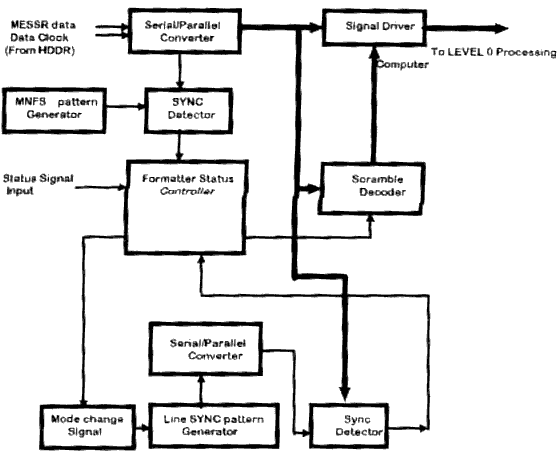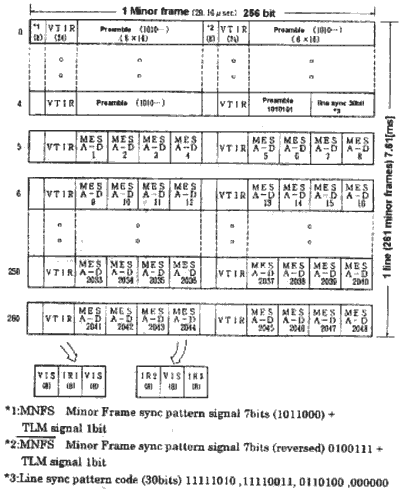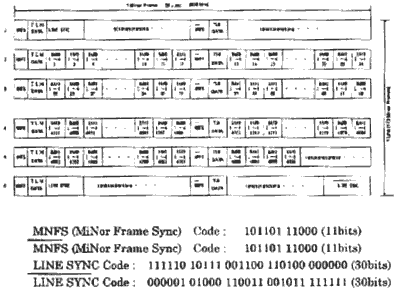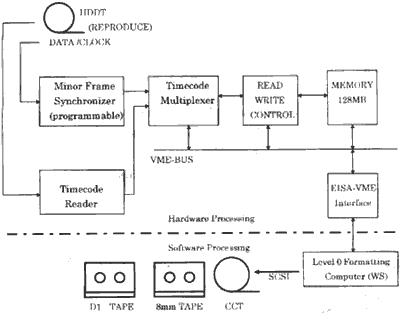| GISdevelopment.net ---> AARS ---> ACRS 1995 ---> Poster Session 4 |
Development of high speed
programmable formatter for earth observation satillite downlink data
formatting
Hideyo Yokotsuka*Toshobumi
Sakata* Haruhisa Shimoda* Shinichi Sobue** Mineo
Sekiguchi***
*Tokai University Research and Information Center
**National Space Development Agency of Japan
***Remote Sensing Technology Center of Japan
Abstract:*Tokai University Research and Information Center
**National Space Development Agency of Japan
***Remote Sensing Technology Center of Japan
Formatting process of earth observation satellite downlink data is usually performed with custom made hardware which designed for one satellite or a sensor. In this paper we introduce a high speed programmable formatter system which is able to process many kinds of satellite downlink data without changing the hardware.
1. Introduction
The various sensor data acquired with earth observation satellites are transmit to ground receiving stations. The sensor data and multiplexed with telemetry using special format called downlink format.
The transfer rate of the down link data to ground receiving station exceeds to 100Mbps, and the quantity of the downlink data per reception exceeds to several GB. Generally, this downlink data is processed through two step as follows. In the first step, the data is record in High Density Digital Tape (HDDT) in real time using High speed Digital Data Recorder (HDDR). In the second step, the downlink data is reproduced from HDDT, sensor data is extracted/divided into each scene unit, and output to certain medium for computer peripheral equipment. Generally, ``The format processing of downlink data'' corresponds to the second step. In order to perform format processing a large quantity of down link data in high transfer to rate. most of the processing systems are consist of customized computer for certain sensor or satellite.
However, in the near future lunch of various kinds of multi sensor satellite such as ADEOS are planned. If we make hardware for each sensor for format processing. It the system, and operation becomes very complicate. It also degradation of reliability of the farmat processing system. This is a very big problem . We have develope a programmable formatter which solved these problems. The hardware dependency was reduced and made multiusable, high speed processing was realized
2. Hardware Formatter
Fig. 1 Shows the block diagram of MOS-1 MESSR formatter as a typical example of synchronization of minor frame, synchronization of major frame and serial to parallel conversion, and done by hardware .It is not only in case of MOS-1 MESSR formatter system, but also in the other sensor formatters. Each formatter hardware are not so different from others. But there is no interchangeability between each formatter at all. It is because we designed speed priority to cope with a large quantity of data. In each system , hardware are customized to realize high speed processing

Figure 1 Block diagram of MOS-1 MESSR hardware synchronizer. Each block is made by discrete device.
3.Investigation of downlink data format of earth observation satellite
Fig 2. Shows the downlink data format of MOS-1 MESSR/VTIR and fig. 3 shows the downlink data format of JERS-1 OPS as typical examples

Figure 2 Downlink data format of MOS-1 MESSR/VTIR

Figure 3 Downlink data format of JERS-1 OPS
Through for our investigation of many satellite downlink data format we have found that the way to specify recording start location of sensor data from minor frame sync pattern is same *(1), *(2).
If we make a circuit which is able to take synchronization for minor frame of any kind of patterns, we can process all downlink format . Paying attention to this facts, we have developed a new formatter system with low hardware dependency.
4 Programmable formatter system
It is very important point in formatter system to keep efficiency of processing speed when serial data is reproduced from HDDR. However, if the ratio of hardware processing to high multiusability drops. By our system, processing by the hardware is only limited to detection of minor frame and addition the time code for format processing as shown fig 4 .This system is allows to take synchronization by only setting a parameter in programmable sync hardware for various minor frame patterns. It adapts to many downlink data format without changing the hardware. Processing difference due to types of sensor or satellites are solved by a software on WS with high speed and high multiusability.

Figure 4 Block diagram of the programmable formatter system
5 Analysis and results
We used the downlink data of MOS-1 MESSR/VTIR for analyzing the performances of the programmable formatter. Fig. 5 shows the processing time result compared with the hardware formatter currently used at a ground station. But, due to the from of difference of the system structure, we could not use the same output equipment for analysis. So, we measured time of the main processing, and the write time to CCT is not included. And both were equal as a result of having done format processing. The processing time of the programmable formatter was a tenth time faster than the previous hardware formatter. This result proves the high speed performance of the programmable formatter.
| Hardware Formatter System | Programmable Formatter System | |
| Control Computer | MS-175 | HP9000/755 |
| Processing Time [S] | About 600 | About 60 |
6 Summary
Recently it is becoming necessary to process downlink data of earth observation satellites at ground receiving station if distribute it to end users in timely manner. Moreover, in order adjust to various satellite programs construction of flexible data reception and processing system with has become important. It was the aim of our study to develop the high speed programmable formatter to cope with such actual situation. The sensor data used in this experiment was of MESSR of MOS-1 . We are planing to perform the quantitative analysis of the programmable formatter in this with other sensor data and intend to upgrade of the system.
7 References
- JERS-1 SAR-AMI IMAGE MOS-1 DATA USERS HANDBOOK National Space Development Agency Of Japan Earth Observation Center 2nd edition (HE 93065A) April,1995
- JERS-1 OPS data format instruction National Space Development Agency Of Japan, Earth Observation Center 2nd edition (HE 93064 A) April,1995